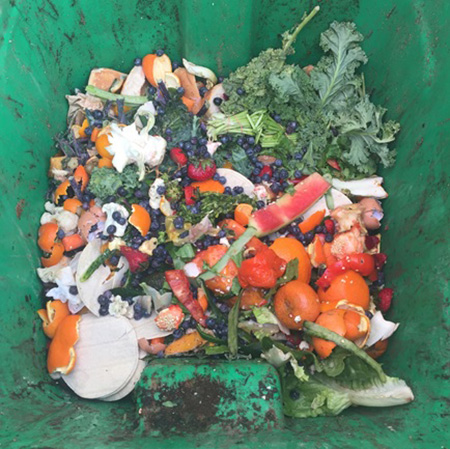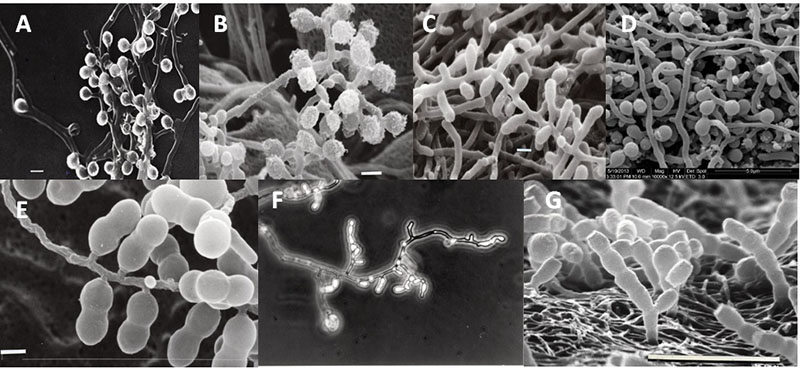As an urban compost coordinator I have supervised efforts to increase compost collection both commercially and residentially in New York City over the past five years. The job has offered an intriguing vantage to assess the future of urban waste-driven economies. This post discusses the microbial capitalism on display in the compost pile, looking beyond today’s relatively transient Anthropocene toward the far more enduring Putrecene.
One Person’s Trash…
Organic waste is estimated to constitute about a third of the waste stream in the U.S. This is a substantial volume of material—the primary producer of greenhouse gases in landfills. There is little motivation in denser geographies to build new landfills or incinerators to manage this material. As such, the economics of shipping waste further and further afield has raised investment and spurred the development of anaerobic and aerobic digestion systems for this waste stream across the globe.

A potpourri.
Hierarchies are created to help reduce organic waste at various points in its lifecycle. Startups are built around the concept of selling ugly, misshapen, or otherwise unmarketable or overproduced food, and volleys are lobbed over whether producers or consumers should feel guiltier about food waste. A closer look at this waste stream reveals that, by volume, there is more edible or useful food than detritus like apple cores or carrot peels. The tonnage of edible waste coming from expensive upscale restaurants subsumes concerns of overproduction vs. overconsumption, revealing that waste itself as a driving force behind extremely late capitalist production. Whether it be food, clothes, or luxury condos, the purchase of excess is where the utility lies. The copious vacant luxury condos do not need to be lived in and the glamour food does not need to be eaten because the most important act of the transaction has already occurred.
The compost pile that is used to manage food waste provides an important lens into the future effects of our waste driven economy. When waste with high nitrogen content, such as food waste, is mixed with bulky, carbon-rich material like leaves and wood chips, the mixture gradually transforms from a number of distinct ingredients into compost. Compost is a nutrient, bacteria, and fungal rich soil amendment that has a number of uses from a replacement for synthetic fertilizers, to a tool in ecological restoration, to a growing medium, as well as possible transformation into a fungicidal or pesticidal spray. This process is performed almost entirely by bacteria with fungi and macro-decomposers like insects playing a role at certain times and in different compost systems. Humans simply give these bacteria the conditions needed to thrive such as air (whether it be forced aeration or physically turning a compost pile), water, and nutrients, like the aforementioned carbon for energy production and nitrogen for protein production/reproduction. This process occurs naturally on the forest floor, for example, and is simply sped up at compost facilities by giving the bacteria optimal conditions to break down material at a rate that is economically viable.
Extremophilic Reproduction
Microbiologists and soil scientists have identified the species of bacteria that thrive in the various stages of a compost pile. They range from cooler temperature mesophilic bacteria to thermophilic bacteria that thrive in the extreme 55+°C temperatures that are created by the metabolism of mesophilic bacteria. They range from rod-shaped bacilli to sphere-shaped cocci, to spiral-shaped spirilla and on to filamentous actinobacteria that break down more complex organic materials. It is the bacilli that are most present at extreme heat but the specific species of bacteria is not of interest to the average composter as long as they continue to do their job. And they will continue to do their job because they are physically everywhere and present on each piece of material that enters the compost pile. These bacteria survive in the unfavorable conditions outside the compost pile by forming endospores that make them immune to both adverse environmental conditions as well as a lack of suitable nutrition and re-emerge once favorable conditions are met in the compost pile.
Recent discoveries of some bacterial species’ ability to consume nuclear waste, plastic waste, and other toxic materials has garnered some warranted excitement. The composter’s challenge is figuring out how to create conditions favorable to these species so that they can proliferate and rapidly digest whichever materials they have evolved to feed on. This process, however, may not be as anthropocentric as those studying these bacteria and those with vested interests in them suggest. While the average generation time for different species of bacteria varies, it is minuscule compared to macrobiotic lifeforms. For example, E. coli divides every 20 minutes while others could divide every few hours. This enables them to adapt to different conditions and different available nutritional sources at a rapid rate, making it very likely that they will continue evolving toward a maximal capacity to thrive in nuclear waste dumps or plastic-filled landfills regardless of human input.

The inheritors of the planet? (www.intechopen.com)
A byproduct of post-industrial humanity’s inability to solve various waste problems has been the cultivation of a fertile bacterial feeding ground. And bacteria have acted on their own pragmatic volition to begin consuming this waste and have, ostensibly, been doing it since well before humanity noticed. While it may be difficult to conceptualize these extremophiles occupying underground nuclear waste dumps as thriving ecological systems, their robustness seems indirectly correlated to the degradation of macroscopic ecosystems (see the disappearance of North American birds or global fisheries). The microbes consuming our rubbish are even outpacing anthropocentric ecosystem transformation. That is, the Anthropocene may well be surpassed by the Putrecene before all that subterranean carbon is released into the atmosphere.
Further, the ideal conditions needed for these extremophile bacteria to thrive already exist for the most part and will certainly continue to develop. As more overproduction and overconsumption yield more waste and increase global temperatures, it will be the extremophiles that survive to consume our leftovers. As 50°C becomes common in our equatorial geographies and our fickle human cells begin to cook, it will be bacteria of all shapes that inherit the earth and transform it into their own environment once again.
The rise in popularity and usage of the term Anthropocene is warranted, as are discussions over how to handle anthropogenic environmental issues like organic, nuclear, or plastic waste, but there is a glaring oversight of the coming bacteriogenic age. It is the Putrecene that will be the evolutionary epoch of note as all-consuming bacteria devour the extravagance of the much shorter Anthropocene and render it back into elemental form.
*The author of this post is using an alias because some of the expressed views are potentially incongruent with those of their employer.
